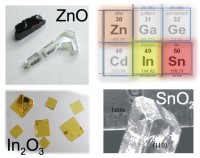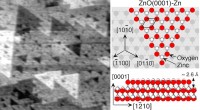This is an old revision of the document!
Post-transition metal oxides ...
… transparent, electrically conducting, and with intriguing surfaces
 We are also interested in non-transition metal oxides, specifically in the ones with a full d-shell: ZnO, SnO2, and In2O3. These materials have a band gap of the order of 3 eV (meaning they are optically transparent) and an s-like conduction band (which implies that they conduct quite well when they are doped a little). The combination of these properties is as rare as it is useful; so-called transparent optical conductors are needed in virtually any technology that combines light with electronics. The conductivity of these materials changes easily when they are exposed to oxidizing or reducing gases, a property which is richly exploited in chemical sensing. And, as is true for most metal oxides, ZnO, In2O3, and SnO2 play a role in catalysis. Again, surfaces and interfaces are critical wherever these materials are used, so we want to learn more about them.
We are also interested in non-transition metal oxides, specifically in the ones with a full d-shell: ZnO, SnO2, and In2O3. These materials have a band gap of the order of 3 eV (meaning they are optically transparent) and an s-like conduction band (which implies that they conduct quite well when they are doped a little). The combination of these properties is as rare as it is useful; so-called transparent optical conductors are needed in virtually any technology that combines light with electronics. The conductivity of these materials changes easily when they are exposed to oxidizing or reducing gases, a property which is richly exploited in chemical sensing. And, as is true for most metal oxides, ZnO, In2O3, and SnO2 play a role in catalysis. Again, surfaces and interfaces are critical wherever these materials are used, so we want to learn more about them.
Zinc oxide - not only in sun lotion
 With STM we have looked at all the low-index surfaces of ZnO [1], a material with applications from the rubber and concrete industries to corrosion protection, and also a component of many sun lotions: Its bandgap is just conveniently wide to absorb UV light while transmitting the visible spectrum. Of particular interest are the (0001)-oriented basal planes, as these are strictly polar - but polar surfaces should not exist because it would cost almost infinite energy to create them! Together with Georg Kresse from the University of Vienna we have found out how the Zn-terminated surface deals with its polarity: It forms many small islands with O-terminated step edges, providing additional negatively charged oxygen ions, compensating for the excess positive charge of the zinc [2].
With STM we have looked at all the low-index surfaces of ZnO [1], a material with applications from the rubber and concrete industries to corrosion protection, and also a component of many sun lotions: Its bandgap is just conveniently wide to absorb UV light while transmitting the visible spectrum. Of particular interest are the (0001)-oriented basal planes, as these are strictly polar - but polar surfaces should not exist because it would cost almost infinite energy to create them! Together with Georg Kresse from the University of Vienna we have found out how the Zn-terminated surface deals with its polarity: It forms many small islands with O-terminated step edges, providing additional negatively charged oxygen ions, compensating for the excess positive charge of the zinc [2].
Sniffing gases with tin oxide
SnO2 is the prototypical material used in gas sensing; how its surfaces are used in this and in various other applications is summarized in this review [3]. The SnO2(011) surface is a particularly nice model system – when oxygen is removed or added, the surface does not 'reconstruct', i.e., it keeps its symmetry. In addition, the surfaces of SnO2 nanowires have mostly this orientation [4].
You are looking through this material
The most common transparent optical conductor to date is In2O3; usually it is doped with Sn and called ITO. Among other applications, e.g., for solar cells, it is used for transparent electrodes of LCD screens like the one you are probably sitting in front of. For our first STM experiments we grew epitaxial thin films [5, 6]; recently we have started to work on In2O3 single crystals [7]. More exciting results still to come!
References
- O. Dulub, L. A. Boatner, U. Diebold
STM study of the geometric and electronic structure of ZnO(0001)-Zn, (000-1)-O, (10-10), and (11-20) surfaces
Surf. Sci. 519, 201-217 (2002) ⋅ full text* - O. Dulub, U. Diebold, G. Kresse
Novel Stabilization Mechanism on Polar Surfaces: ZnO(0001)-Zn
Phys. Rev. Lett. 90, 016102 (2003) ⋅ full text - M. Batzill, U. Diebold
The surface and materials science of tin oxide
Prog. Surf. Sci. 79, 47-154 (2005) ⋅ full text* - K. Katsiev, A. Kolmakov, M. Fang, U. Diebold
Characterization of individual SnO2 nanobelts with STM
Surf. Sci. 602, L112-L114 (2008) ⋅ full text* - E.H. Morales, Y. He, M. Vinnichenko, B. Delley, U. Diebold
Surface structure of Sn-doped In2O3(111) thin films by STM
New J. Phys. 10, 125030 (2008) ⋅ full text - E.H. Morales, U. Diebold
The structure of the polar Sn-doped indium oxide (001) surface
Appl. Phys. Lett. 95, 253105 (2009) ⋅ full text - D. R. Hagleitner, M. Menhart, P. Jacobson, S. Blomberg, K. Schulte, E. Lundgren, M. Kubicek, J. Fleig, F. Kubel, C. Puls, A. Limbeck, H. Hutter, L. A. Boatner, M. Schmid, and U. Diebold
Bulk and surface characterization of In2O3(001) single crystals
Phys. Rev. B 85, 115441 (2012) ⋅ full text
* Please note: access to full text (PDF files) of some articles is restricted due to copyright reasons.


